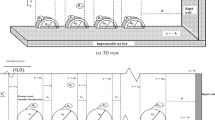Abstract
This study examines the multiple layers in a rubble mound breakwater and their effect on reflection and dissipation of incoming ocean waves. The numerical model is developed using multi-domain boundary element method for oblique water wave trapping near a sloping wall by a multi-layered trapezoidal porous structure, which is utilized to model armour, filter and core layers while examining the hydrodynamics in different configurations. Both, the constant element and linear element approaches to boundary element method are discussed. The cases of bottom-standing porous structures as being submerged and fully extended are considered. The wave hydrodynamics over the structure is described by the reflection and dissipation coefficients along with the forces acting on the sloping wall, and is influenced by wave and structural parametrics of the system. The influence of armour layer in different configurations is highlighted for various structural and wave parameters.













Similar content being viewed by others
References
Ang W-T (2007) A beginner’s course in boundary element methods. Universal-Publishers, Irvine
Au M, Brebbia C (1982) Numerical prediction of wave forces using the boundary element method. Appl Math Model 6(4):218–228
Behera H, Khan MB (2019) Numerical modeling for wave attenuation in double trapezoidal porous structures. Ocean Eng 184:91–106
Behera H, Koley S, Sahoo T (2015) Wave transmission by partial porous structures in two-layer fluid. Eng Anal Bound Elem 58:58–78
Behera H, Sahoo T (2014) Gravity wave interaction with porous structures in two-layer fluid. J Eng Math 87(1):73–97
Bender CJ, Dean RG (2003) Wave transformation by two-dimensional bathymetric anomalies with sloped transitions. Coast Eng 50(1–2):61–84
Bird H, Shepherd R (1984) On the interactions of surface waves with immersed structures. Int J Numer Methods Fluids 4(8):765–780
Cao Y, Jiang C, Bai Y (2012) Wave attenuation properties of double trapezoidal submerged breakwaters on flat-bed. Trans Tianjin Univ 18(6):401–410
Chang H-K, Liou J-C (2007) Long wave reflection from submerged trapezoidal breakwaters. Ocean Eng 34(1):185–191
Dalrymple RA, Losada MA, Martin PA (1991) Reflection and transmission from porous structures under oblique wave attack. J Fluid Mech 224:625–644
Fang Z, Xiao L, Peng T (2017) Generalized analytical solution to wave interaction with submerged multi-layer horizontal porous plate breakwaters. J Eng Math 105(1):117–135
Khan M, Behera H (2020) Analysis of wave action through multiple submerged porous structures. J Offshore Mech Arct Eng 142(1):011101
Koley S, Behera H, Sahoo T (2014) Oblique wave trapping by porous structures near a wall. J Eng Mech 141(3):04014122
Lee J (1995) A boundary element model for waves interaction with porous structures. Trans Model Simul 9:145–152
Lee J-F, Cheng Y-M (2007) A theory for waves interacting with porous structures with multiple regions. Ocean Eng 34(11–12):1690–1700
Lin P, Liu H-W (2005) Analytical study of linear long-wave reflection by a two-dimensional obstacle of general trapezoidal shape. J Eng Mech 131(8):822–830
Liu PL, Abbaspour M (1982) Wave scattering by a rigid thin barrier. J Waterw Port Coast Ocean Div 108(4):479–491
Losada I, Silva R, Losada M (1996) 3-d non-breaking regular wave interaction with submerged breakwaters. Coast Eng 28(1):229–248
Losada IJ, Losada MA, Baquerizo A (1993) An analytical method to evaluate the efficiency of porous screens as wave dampers. Appl Ocean Res 15(4):207–215
Madsen OS, White SM (1977) Wave transmission through trapezoidal breakwaters. Coast Eng 1976:2662–2676
Males RM, Melby JA (2011) Monte Carlo simulation model for economic evaluation of rubble mound breakwater protection in harbors. Front Earth Sci 5(4):432–441
Rojanakamthorn S, Isobe M, Watanabe A (1991) Modeling of wave transformation on submerged breakwater. Coast Eng 1990:1060–1073
Sollitt CK, Cross RH (1972) Wave transmission through permeable breakwaters. In: Proceedings of the 13th international conference on coastal engineering, pp 1827–1846
Sulisz W (1985) Wave reflection and transmission at permeable breakwaters of arbitrary cross-section. Coast Eng 9(4):371–386
Twu S-W, Chieu C-C (2000) A highly wave dissipation offshore breakwater. Ocean Eng 27(3):315–330
Twu S-W, Liu C-C, Hsu W-H (2001) Wave damping characteristics of deeply submerged breakwaters. J Waterw Port Coast Ocean Eng 127(2):97–105
Wang CD, Meylan MH (2002) The linear wave response of a floating thin plate on water of variable depth. Appl Ocean Res 24(3):163–174
Wang Y, Wang G, Li G (2006) Experimental study on the performance of the multiple-layer breakwater. Ocean Eng 33(13):1829–1839
Xie J-J, Liu H-W (2013) Analytical study for linear wave transformation by a trapezoidal breakwater or channel. Ocean Eng 64:49–59
Zhao Y, Li H, Liu Y (2017a) Oblique wave scattering by a submerged porous breakwater with a partially reflecting sidewall. J Mar Sci Technol 25(4):383–392
Zhao Y, Liu Y, Li H, Chang A (2017b) Oblique wave motion over multiple submerged porous bars near a vertical wall. J Ocean Univ China 16(4):568–574
Zheng Y, Shen Y, Ng C-O (2008) Effective boundary element method for the interaction of oblique waves with long prismatic structures in water of finite depth. Ocean Eng 35(5):494–502
Acknowledgements
HB gratefully acknowledges the financial support from SERB, Department of Science and Technology, Government of India through “CRG” Pgroject, Award No. CRG/2018/004521.
Author information
Authors and Affiliations
Corresponding author
Ethics declarations
Conflict of interest
We have no conflict of interest.
Additional information
Publisher's Note
Springer Nature remains neutral with regard to jurisdictional claims in published maps and institutional affiliations.
Rights and permissions
About this article
Cite this article
Khan, M.B.M., Behera, H., Sahoo, T. et al. Boundary element method for wave trapping by a multi-layered trapezoidal breakwater near a sloping rigid wall. Meccanica 56, 317–334 (2021). https://doi.org/10.1007/s11012-020-01286-z
Received:
Accepted:
Published:
Issue Date:
DOI: https://doi.org/10.1007/s11012-020-01286-z




